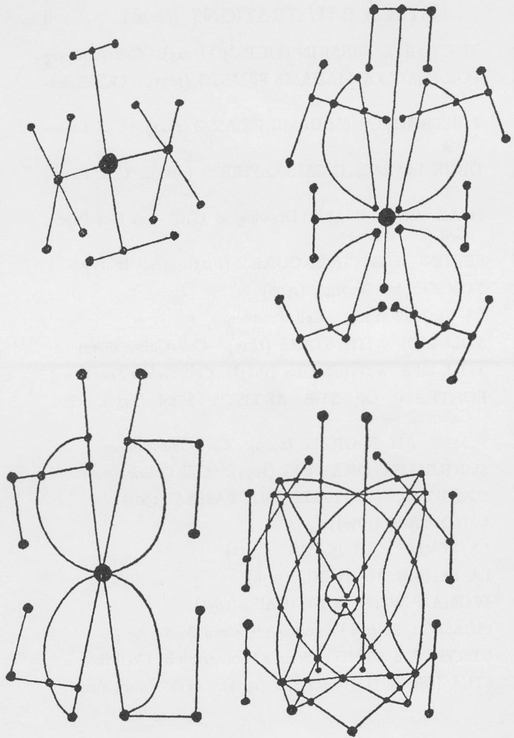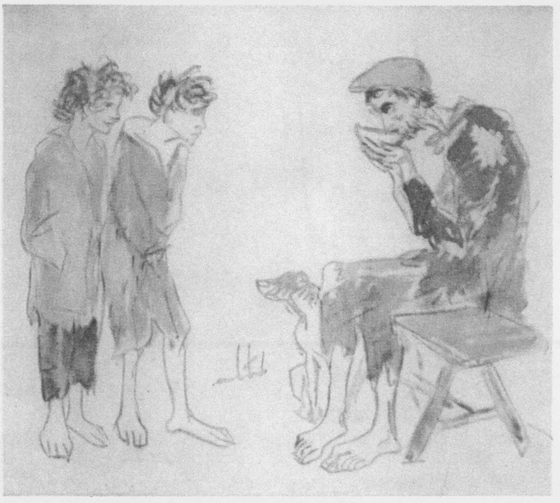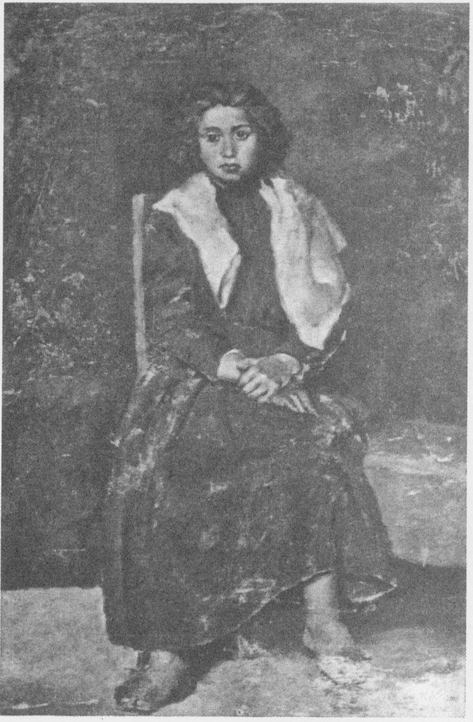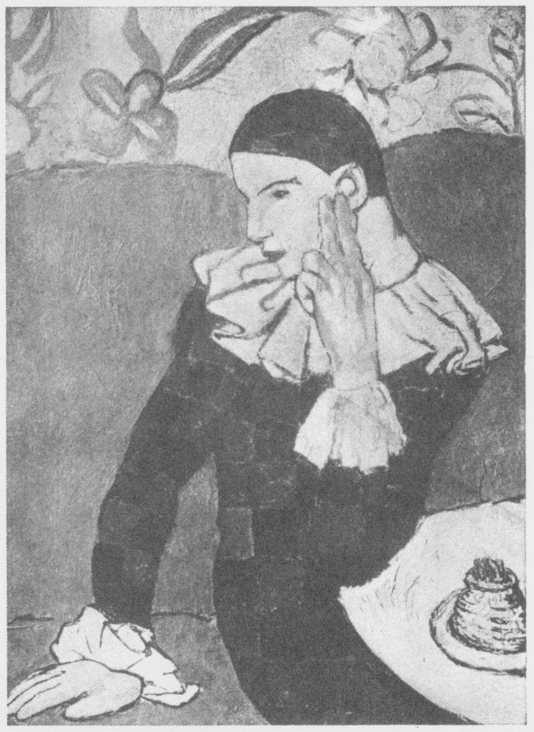Title.
ND553.P5S8 1984
759.4
84-5934
9780486136523
Manufactured in the United States by Courier Corporation
24715518
www.doverpublications.com
Table of Contents
DOVER BOOKS ON FINE ART
Title Page
Copyright Page
PICASSO
INDEX
A CATALOG OF SELECTED DOVER BOOKS IN ALL FIELDS OF INTEREST

LINES AND STARS
Drawing in Pure Calligraphy (1923)

2 LES PAUVRES : Water Colour (1902)
PICASSO
PAINTING in the nineteenth century was only done in France and by Frenchmen, apart from that, painting did not exist, in the twentieth century it was done in France but by Spaniards.
In the nineteenth century painters discovered the need of always having a model in front of them, in the twentieth century they discovered that they must never look at a model. I remember very well, it was between 1904-1908, when people were forced by us or by themselves to look at Picasso’s drawings that the first and most astonishing thing that all of them and that we had to say was that he had done it all so marvellously as if he had had a model but that he had done it without ever having had one. And now the young painters scarcely know that there are models. Everything changes but not without a reason.
When he was nineteen years old Picasso came to Paris, that was in 1900, into a world of painters who had completely learned everything they could from seeing at what they were looking. From Seurat to Courbet they were all of them looking with their eyes and Seurat’s eyes then began to tremble at what his eyes were seeing, he commenced to doubt if in looking he could see. Matisse too began to doubt what his eyes could see. So there was a world ready for Picasso who had in him not only all Spanish painting but Spanish cubism which is the daily life of Spain.
His father was professor of painting in Spain and Picasso wrote painting as other children wrote their a b c. He was born making drawings, not the drawings of a child but the drawings of a painter. His drawings were not of things seen but of things expressed, in short they were words for him and drawing always was his only way of talking and he talks a great deal.
Physically Picasso resembles his mother whose name he finally took. It is the custom in Spain to take the name of one’s father and one’s mother. The name of Picasso’s father was Ruiz, the name of his mother was Picasso, in the Spanish way he was Pablo Picasso y Ruiz and some of his early canvases were signed Pablo Ruiz but of course Pablo Picasso was the better name, Pablo Picasso y Ruiz was too long a name to use as a signature and he commenced almost at once to sign his canvases Pablo Picasso.
The name Picasso is of Italian origin, probably originally they came from Genoa and the Picasso family went to Spain by way of Palma de Mallorca. His mother’s family were silversmiths. Physically his mother like Picasso is small and robust with a vigorous body, dark-skinned, straight not very fine nearly black hair, on the other hand Picasso always used to say his father was like an Englishman of which both Picasso and his father were proud, tall and with reddish hair and with almost an English way of imposing himself:
The only children in the family were Picasso and his younger sister. He made when he was fifteen years old oil portraits of her, very finished and painted like a born painter.

3 GIRL WITH BARE FEET (1895)

4 HARLEQUIN AND MATCHES (1901)
Picasso was born in Malaga the 25th of October 1881 but he was educated almost entirely in Barcelona where his father until almost the end of his life was professor of painting at the academy of Fine Arts and where he lived until his death, his mother continued living there with his sister. She has just died there.
Well then, Picasso at nineteen years of age was in Paris where, except for very rare and short visits to Spain, he has lived all his life.
He was in Paris.
His friends in Paris were writers rather than painters, why have painters for friends when he could paint as he could paint.
It was obvious that he did not need to have painters in his daily life and this was true all his life.
He needed ideas, anybody does, but not ideas for painting, no, he had to know those who were interested in ideas, but as to knowing how to paint he was born knowing all of that.
So in the beginning he knew intimately Max Jacob and at once afterwards Guillaume Apolliniaire and André Salmon, and later he knew me and much later Jean Cocteau and still later the Surréalistes, this is his literary history. His intimates amongst the painters, and this was later, much later than Max Jacob and than Guillaume Apollinaire and than André Salmon and than I, were Braque and Derain, they both had their literary side and it was this literary side that was the reason for their friendship with Picasso.
The literary ideas of a painter are not at all the same ideas as the literary ideas of a writer. The egotism of a painter is entirely a different egotism than the egotism of a writer.
The painter does not conceive himself as existing in himself, he conceives himself as a reflection of the objects he has put into his pictures and he lives in the reflections of his pictures, a writer, a serious writer, conceives himself as existing by and in himself, he does not at all live in the reflection of his books, to write he must first of all exist in himself, but for a painter to be able to paint, the painting must first of all be done, therefore the egotism of a painter is not at all the egotism of a writer, and this is why Picasso who was a man who only expressed himself in painting had only writers as friends.
In Paris the contemporary painters had little effect upon him but all the painting he could see of the very recent past profoundly touched him.
He was always interested in painting as a metier, an incident that happened once is characteristic. In Paris there was an American sculptress who wished to show her canvases and sculpture at the salon. She had always shown her sculpture at the salon where she was hors concours but she did not wish to show sculpture and painting at the same salon. So she asked Miss Toklas to lend her her name for the pictures. This was done. The pictures were accepted in the name of Miss Toklas, they were in the catalogue and we had this catalogue. The evening of the vernissage Picasso was at my house. I showed him the catalogue, I said to him, here is Alice Toklas who has never painted and who has had a picture accepted at the salon. Picasso went red, he said, it’s not possible, she has been painting in secret for a long time, never I tell you, I said to him. It isn’t possible, he said, not possible, the painting at the salon is bad painting, but even so if any one could paint as their first painting a picture that was accepted, well then I don’t understand anything about anything. Take it easy, I said to him, no she didn’t paint the picture, she only lent her name. He was still a little troubled, no, he repeated, you have to know something to paint a picture, you have to, you have to.
Well he was in Paris and all painting had an influence upon him and his literary friends were a great stimulation to him. I do not mean that by all this he was less Spanish. But certainly for a short time he was more French.
1 comment